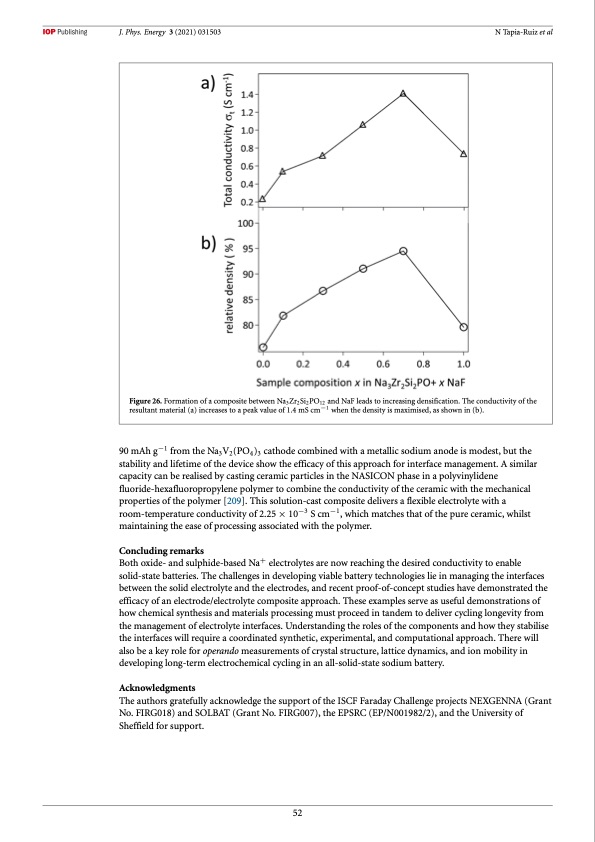
PDF Publication Title:
Text from PDF Page: 053
J. Phys. Energy 3 (2021) 031503 N Tapia-Ruiz et al Figure 26. Formation of a composite between Na3Zr2Si2PO12 and NaF leads to increasing densification. The conductivity of the resultant material (a) increases to a peak value of 1.4 mS cm−1 when the density is maximised, as shown in (b). 90 mAh g−1 from the Na3V2(PO4)3 cathode combined with a metallic sodium anode is modest, but the stability and lifetime of the device show the efficacy of this approach for interface management. A similar capacity can be realised by casting ceramic particles in the NASICON phase in a polyvinylidene fluoride-hexafluoropropylene polymer to combine the conductivity of the ceramic with the mechanical properties of the polymer [209]. This solution-cast composite delivers a flexible electrolyte with a room-temperature conductivity of 2.25 × 10−3 S cm−1, which matches that of the pure ceramic, whilst maintaining the ease of processing associated with the polymer. Concluding remarks Both oxide- and sulphide-based Na+ electrolytes are now reaching the desired conductivity to enable solid-state batteries. The challenges in developing viable battery technologies lie in managing the interfaces between the solid electrolyte and the electrodes, and recent proof-of-concept studies have demonstrated the efficacy of an electrode/electrolyte composite approach. These examples serve as useful demonstrations of how chemical synthesis and materials processing must proceed in tandem to deliver cycling longevity from the management of electrolyte interfaces. Understanding the roles of the components and how they stabilise the interfaces will require a coordinated synthetic, experimental, and computational approach. There will also be a key role for operando measurements of crystal structure, lattice dynamics, and ion mobility in developing long-term electrochemical cycling in an all-solid-state sodium battery. Acknowledgments The authors gratefully acknowledge the support of the ISCF Faraday Challenge projects NEXGENNA (Grant No. FIRG018) and SOLBAT (Grant No. FIRG007), the EPSRC (EP/N001982/2), and the University of Sheffield for support. 52PDF Image | 2021 roadmap for sodium-ion batteries

PDF Search Title:
2021 roadmap for sodium-ion batteriesOriginal File Name Searched:
roadmap-sodium-ion-batteries_031503.pdfDIY PDF Search: Google It | Yahoo | Bing
Salgenx Redox Flow Battery Technology: Salt water flow battery technology with low cost and great energy density that can be used for power storage and thermal storage. Let us de-risk your production using our license. Our aqueous flow battery is less cost than Tesla Megapack and available faster. Redox flow battery. No membrane needed like with Vanadium, or Bromine. Salgenx flow battery
| CONTACT TEL: 608-238-6001 Email: greg@salgenx.com | RSS | AMP |